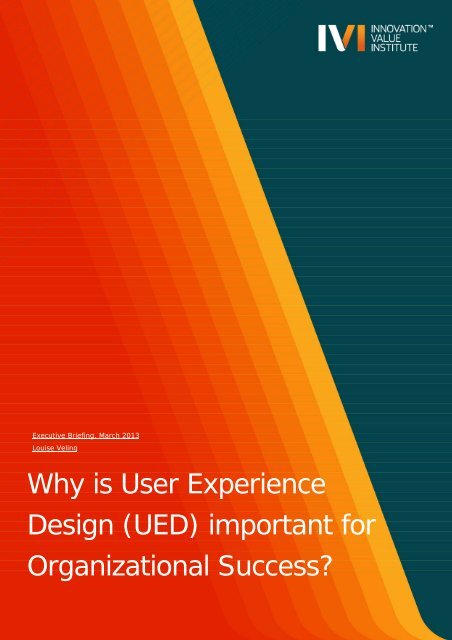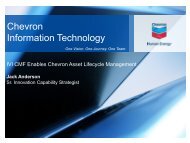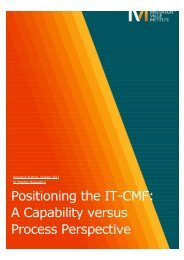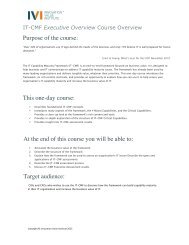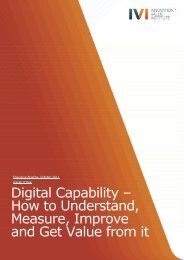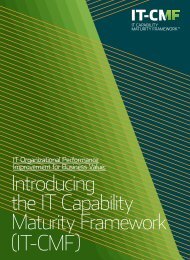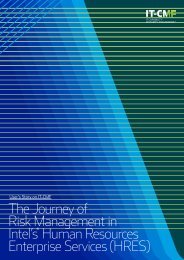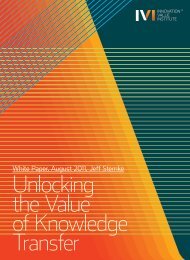Why is User Experience Design - IVI Innovation Value Institute ...
Why is User Experience Design - IVI Innovation Value Institute ...
Why is User Experience Design - IVI Innovation Value Institute ...
You also want an ePaper? Increase the reach of your titles
YUMPU automatically turns print PDFs into web optimized ePapers that Google loves.
Page 1<br />
Executive Briefing, March 2013<br />
Lou<strong>is</strong>e Veling<br />
<strong>Why</strong> <strong>is</strong> <strong>User</strong> <strong>Experience</strong><br />
<strong>Design</strong> (UED) important for<br />
Organizational Success?
Abstract<br />
<strong>User</strong> <strong>Experience</strong> <strong>Design</strong> (UED) ensures that the focus of<br />
Information and Communication Technology (ICT) <strong>is</strong> on<br />
the people for whom it <strong>is</strong> being created; including<br />
technology users, customers and the business. Globally,<br />
organizations are coming to realize that traditional,<br />
techno-centric methods of technology development can<br />
lead to high rates of project failure. Additionally, users<br />
and user-derived data <strong>is</strong> rapidly becoming more<br />
important to organizational innovation and to the<br />
identification of emerging technological opportunities.<br />
The UED approach can also be used successfully outside<br />
of ICT to increase business value; for example, in the<br />
area of service or business design.<br />
KEYWORDS: IT-CMF, user experience, business value, organizational success, <strong>User</strong><br />
<strong>Experience</strong> <strong>Design</strong> (UED), UED, innovation, service innovation<br />
Introduction<br />
In order to drive competitive advantage,<br />
the need to embed a <strong>User</strong> <strong>Experience</strong><br />
<strong>Design</strong> (UED) capability into your<br />
organizational culture has never been more<br />
pressing. <strong>User</strong> <strong>Experience</strong> <strong>is</strong> often<br />
associated with the cosmetics or design of a<br />
product; the reality, however, <strong>is</strong> much<br />
broader (EU Comm<strong>is</strong>sion, 2009). UED <strong>is</strong><br />
about putting the user or consumer at the<br />
centre of a design and development process<br />
– from the conceptual or research stage<br />
through to realization and beyond. UED<br />
provides the tools and framework to<br />
achieve th<strong>is</strong> in a way that has implications<br />
for the organization far beyond the confines<br />
of the IT department. “When user<br />
experience design...brings together<br />
business objectives, user requirements, and<br />
IT capabilities, then the IT organization <strong>is</strong> in<br />
a position to leverage these three inputs<br />
into a significantly large amount of business<br />
value” (Sward, 2006, p. 4).<br />
The world’s leading technology companies,<br />
most notably Apple, have ra<strong>is</strong>ed the bar for<br />
user experience, and people have become<br />
more soph<strong>is</strong>ticated in what they expect<br />
from the technologies that they engage<br />
with. Globally, organizations are embracing<br />
<strong>User</strong> <strong>Experience</strong> as never before, while user<br />
experience designers strive to make<br />
technology “ubiquitous”, or inv<strong>is</strong>ible, and in<br />
the best instances, genuinely pleasurable to<br />
use.<br />
<strong>User</strong> experience <strong>is</strong> developing into a<br />
multi-d<strong>is</strong>ciplinary field that ideally draws<br />
experts from a number of different<br />
d<strong>is</strong>ciplines; including design, technology,<br />
business, marketing, anthropology,<br />
sociology, and psychology. The role of UED<br />
could be seen as a lia<strong>is</strong>on, bringing multiple<br />
perspectives to developing a new product.<br />
(Hess, 2009).<br />
How <strong>User</strong> <strong>Experience</strong> contributes to<br />
Organizational Success<br />
The way we do business <strong>is</strong> changing. There<br />
<strong>is</strong> an increasing need to ensure value from<br />
investments, particularly in relation to IT.<br />
Technology continues to develop at a rapid<br />
pace, “people and machines are connected<br />
in more ways than ever before – and<br />
making new connections, all the time”<br />
(Accenture, 2012). For CIOs, these<br />
challenges are particularly acute, “perhaps<br />
no C-level position has undergone as many<br />
changes in expectations, approaches, and<br />
philosophies during the past few decades.”<br />
(Evans, 2012). Technology users are also<br />
changing and are becoming more<br />
soph<strong>is</strong>ticated and d<strong>is</strong>cerning as to what<br />
products and services they will use.<br />
Additionally, services are increasingly seen<br />
as a way of differentiating an organization<br />
in a marketplace where supply largely<br />
outstrips demand. Key differentiators in<br />
terms of customer engagement are based<br />
not only on cost, but also on accessibility,<br />
customization, and personalization of the<br />
Page 2
product or service. Because of th<strong>is</strong> growing<br />
realization, there <strong>is</strong> an urgent need to focus<br />
on service research and innovation. A<br />
significant aspect of such research and<br />
innovation <strong>is</strong> focused on how people<br />
interact with organizations that have<br />
become largely virtual; operating and<br />
connecting with the world through digital<br />
channels.<br />
UED <strong>is</strong> in a unique position to address all of<br />
these challenges and work with ex<strong>is</strong>ting<br />
processes and initiatives to boost an<br />
organization’s competitive strategy, most<br />
notably with regard to its potential to boost<br />
such an organization’s innovation<br />
capabilities. Apple has led the way in<br />
transforming its business by putting user<br />
experience at the centre of its design and<br />
development processes. However, the gap<br />
between Apple and its competitors <strong>is</strong> closing<br />
as Apple’s rivals come to realize the<br />
potential of effectively capturing and<br />
understanding the user experience. Google<br />
has created a new “UXA” team that <strong>is</strong><br />
responsible for designing and developing a<br />
user interface framework to transform its<br />
web offering and work closely with other<br />
user experience teams, stakeholders, and<br />
the business (The Verge, 2013). In<br />
February 2010, the new chief of Samsung’s<br />
telecom business, J.K. Shin, wrote in a<br />
memo to h<strong>is</strong> top executives that the<br />
difference between their company’s user<br />
experience and that of Apple was “truly that<br />
of heaven and earth” (Sherr and Ramstad,<br />
2013). Within a few months th<strong>is</strong> change of<br />
focus resulted in the release of the<br />
Galaxy S, l<strong>is</strong>ted by TIME as number 2 in the<br />
Top 10 Gadgets of 2010 (Aamoth, 2010).<br />
To help guide its product development,<br />
Philips Electronics assembled a<br />
multi-d<strong>is</strong>ciplinary design team to develop a<br />
new v<strong>is</strong>ion of the user experience. The<br />
result <strong>is</strong> the Ambient <strong>Experience</strong> for<br />
Healthcare, which, says Thomas van<br />
Elzakker, former manager for new ventures,<br />
“has strengthened Philip’s €3.27 billion<br />
imaging business around the world, allowed<br />
it to realize higher prices, and improved its<br />
profitability”. In addition, it has improved<br />
the patient experience for many thousands<br />
of people (EU Comm<strong>is</strong>sion, 2012). Laying<br />
out her new strategy for Yahoo! in January<br />
2013, Marr<strong>is</strong>a Meyer announced the need<br />
“to bolster our user experiences”<br />
(MacMillan, 2013).<br />
The huge potential of user experience and<br />
user-driven design for organizational<br />
success has prompted a number of<br />
European “innovation leaders”, such as<br />
Finland, Denmark, and the UK to include<br />
user-centred design “as cornerstones of<br />
their national innovation strategies”.<br />
Strategies to include users in the design<br />
process, including UED, are seen as “a way<br />
of providing innovative products, services<br />
and systems that correspond better to user<br />
needs and hence are more competitive”<br />
(Comm<strong>is</strong>sion Working Document, 2009).<br />
The EU Comm<strong>is</strong>sion agrees “never before<br />
has so clear an opportunity ex<strong>is</strong>ted as now,<br />
for the European Comm<strong>is</strong>sion, Member<br />
States and regions to take bold action to<br />
enable a new level of awareness about the<br />
importance of design as a driver of usercentred<br />
innovation across Europe” (EU<br />
Comm<strong>is</strong>sion, 2012). Eric Von Hippel,<br />
Professor of Management of <strong>Innovation</strong> at<br />
MIT Sloan, has identified the extremely high<br />
failure rates of new products due to the lack<br />
of understanding of user needs (Von Hippel,<br />
2005, p. 108). The benefit of user-centred<br />
approaches can also be applied to design<br />
approaches in other sectors: for example;<br />
business operations, and – crucially –<br />
service design and service innovation. The<br />
field of New Service Development identifies<br />
users as “the most important source of<br />
[service] innovation” (Sundbo and<br />
Toivonen, 2012, p. 5).<br />
It <strong>is</strong> clear that organizations are benefitting<br />
from, and recognize the potential of<br />
focusing on user experience when designing<br />
new products and services for customers.<br />
However, all organizations can benefit from<br />
ensuring their IT function becomes more<br />
user-centric. Investing time and effort on<br />
user experience when creating and<br />
selecting new products and services for<br />
internal use has multiple benefits for any<br />
organization, irrespective of size. Some of<br />
these include decreased development time<br />
and need for rework; lowered maintenance<br />
costs; reduced need for user support and<br />
training; increased user productivity,<br />
engagement, motivation and adoption of<br />
new technologies; and improved<br />
communication between the IT organization<br />
and the rest of the business.<br />
UED and user-centred practices have a<br />
potential to enhance not only the IT<br />
function, the wider organization, and the<br />
way we do business; but also society as a<br />
whole. Putting citizens at the centre of the<br />
development process can drive “better,<br />
transparent and more effective public<br />
services and contributions to social<br />
innovation, thereby ra<strong>is</strong>ing the quality of life<br />
for all citizens... and for complex societal<br />
problems, design offers people-centred<br />
approaches that can achieve better<br />
solutions” (Comm<strong>is</strong>sion Working Document,<br />
2009).<br />
How to develop your UED<br />
Capability<br />
<strong>User</strong> <strong>Experience</strong> <strong>Design</strong> (UED) <strong>is</strong> one of the<br />
critical capabilities that make up the IT<br />
Capability Maturity Framework (IT-CMF),<br />
which has been developed to help<br />
organizations identify the relevant aspects<br />
of the capabilities they need to improve on.<br />
The framework provides the tools and<br />
guidance to help organizations define and<br />
Page 3
develop their maturity to a level that <strong>is</strong><br />
appropriate to their requirements. By taking<br />
the time to understand their current UED<br />
maturity, organizations can focus on the<br />
steps they must take in order to develop<br />
their ability to deliver products and services<br />
in a way that <strong>is</strong> competitive and<br />
sustainable, which in turn <strong>is</strong> a key factor in<br />
developing competitive advantage.<br />
By concentrating on developing a mature<br />
UED capability, organizations can quickly<br />
start to realize significant benefits through<br />
the development and use of user-centred<br />
technologies. Some of the benefits of a<br />
mature UED capability are:<br />
An increase in the success rate of new<br />
products.<br />
Less time and cost incurred in re-work.<br />
Increased user/customer engagement,<br />
loyalty, and retention.<br />
Smoother and faster acceptance and<br />
adoption of technologies.<br />
Access to valuable data that can<br />
contribute to innovation and development<br />
of new products and services.<br />
Near real-time awareness of changing<br />
user needs/expectations.<br />
References<br />
1. Aamoth, D. (2010). The Top 10 Everything of 2010.<br />
Retrieved January 29, 2013 from Time L<strong>is</strong>ts.:<br />
http://www.time.com/time/specials/packages/article/0,2<br />
8804,2035319_2033840_2033837,00.html<br />
2. Accenture (2011), Mobility Trends. Retrieved January 29,<br />
2013 from Accenture Website:<br />
http://www.accenture.com/SiteCollectionDocuments/PDF<br />
/Accenture‐Mobility‐Trends‐Transcript.pdf<br />
3. Comm<strong>is</strong>sion Staff Working Document (2009). <strong>Design</strong> as a<br />
driver of user‐centred innovation; INNOGRIPS MS05<br />
4. European Comm<strong>is</strong>sion, The (2012). <strong>Design</strong> for Growth &<br />
Prosperity: Report and Recommendations of the<br />
European <strong>Design</strong> Leadership Board<br />
5. Evans, B. (2012). The Top 10 Strategic CIO Issues For 2013.<br />
Retrieved January 29, 2013 from Forbes:<br />
http://www.forbes.com/sites/oracle/2012/09/28/<br />
the‐top‐10‐strategic‐cio‐<strong>is</strong>sues‐for‐2013/<br />
6. Hess, W. (2009). 10 Most Common M<strong>is</strong>conceptions About<br />
<strong>User</strong> <strong>Experience</strong> <strong>Design</strong>. Retrieved January 29, 2013 from<br />
Mashable: http://mashable.com/2009/01/09/<br />
user‐experience‐design/<br />
7. Hippel, E. Von (2005). Democrat<strong>is</strong>ing <strong>Innovation</strong>. The MIT<br />
Press.<br />
8. MacMillan, D. (2013). Yahoo teams up with Google on ads.<br />
Retrieved on February 7 th , 2013 from SFGate:<br />
http://www.sfgate.com/technology/article/Yahoo‐teamsup‐with‐Google‐on‐ads‐4258204.php<br />
9. Momentum <strong>Design</strong> Lab (2009). The <strong>Value</strong> of Positive <strong>User</strong><br />
<strong>Experience</strong>. A Whitepaper.<br />
10. Sherr, I., and Ramstad, E. (2013). Has Apple Lost Its Cool to<br />
Samsung? Retrieved January 29, 2013 from Wall Street<br />
Journal:<br />
http://online.wsj.com/article/SB10001424127887323854<br />
904578264090074879024.html<br />
11. Sundbo, J., and Toivonen, M. (2012). <strong>User</strong>‐based<br />
<strong>Innovation</strong> in Services. Edward Elgar Pub.<br />
12. Sward, D. (2006). Measuring the Business <strong>Value</strong> of<br />
Information Technology. Intel Press<br />
13. Verge Staff (2013). Redesigning Google: how Larry Page<br />
engineered a beautiful revolution. Retrieved January 29,<br />
2013 The Verge:<br />
http://www.theverge.com/2013/1/24/3904134/googleredesign‐how‐larry‐page‐engineered‐beautiful‐revolution<br />
14. Finn<strong>is</strong>h Min<strong>is</strong>try of Employment and the Economy<br />
demand‐driven innovations group (2010). Demand and<br />
<strong>User</strong>‐driven <strong>Innovation</strong> Policy – Framework (Part 1) and<br />
Action Plan (Part 2). Government of Finland Min<strong>is</strong>try of<br />
Employment and the Economy<br />
About the Author<br />
Lou<strong>is</strong>e Veling <strong>is</strong> a research fellow at <strong>IVI</strong>.<br />
She <strong>is</strong> lead researcher on four IT-CMF<br />
Critical Capabilities: <strong>User</strong> <strong>Experience</strong> <strong>Design</strong><br />
(UED), Solutions Delivery (SD), Service<br />
Prov<strong>is</strong>ioning (SRP), and IT Leadership and<br />
Governance (ITG). Lou<strong>is</strong>e can be contacted<br />
at: lou<strong>is</strong>e.veling@nuim.ie<br />
Th<strong>is</strong> executive briefing was edited by<br />
Thomas Keogan of TeKcomm Technical<br />
Writing.<br />
About <strong>IVI</strong><br />
The <strong>Innovation</strong> <strong>Value</strong> <strong>Institute</strong> (<strong>IVI</strong>) <strong>is</strong> a<br />
multi-d<strong>is</strong>ciplinary research and education<br />
establ<strong>is</strong>hment co-founded by the National<br />
University of Ireland Maynooth and Intel<br />
Corporation. <strong>IVI</strong> develops frameworks to<br />
ass<strong>is</strong>t IT and business executives to<br />
manage IT for Business <strong>Value</strong> and to deliver<br />
IT-enabled business innovation. <strong>IVI</strong> <strong>is</strong><br />
supported by a global consortium of<br />
like-minded peers drawn from a community<br />
of public and private sector organizations,<br />
academia, analysts, professional<br />
associations, independent software vendors,<br />
and professional services organizations.<br />
Contact Us<br />
For more information on IT-CMF and<br />
current IT hot topics and priorities such as<br />
cloud computing and r<strong>is</strong>k management, or<br />
on becoming a member of the <strong>IVI</strong><br />
Consortium, please v<strong>is</strong>it www.ivi.ie or<br />
contact us at:<br />
ivi@nuim.ie or +353 (0)1 708 6931<br />
<strong>Innovation</strong> <strong>Value</strong> <strong>Institute</strong>, IT Capability<br />
Maturity Framework, and IT-CMF are<br />
trademarks of the <strong>Innovation</strong> <strong>Value</strong><br />
<strong>Institute</strong>. Many of the designations used by<br />
manufacturers and sellers to d<strong>is</strong>tingu<strong>is</strong>h<br />
their products are claimed as trademarks.<br />
Where those designations appear in th<strong>is</strong><br />
document, and the <strong>Institute</strong> was aware of a<br />
trademark claim, the designations have<br />
been printed with initial capital letters or all<br />
in capital letters.<br />
Copyright © 2013<br />
Page 4


